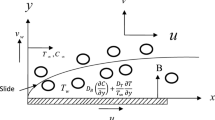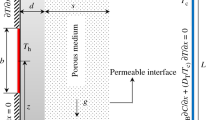Abstract
In many processes such as microwave heating, chemical reaction, pasteurization, sterilization, heat transfer convection is occurred by means of purely internal heating sources, instead of heating solid surfaces. This paper deals with the analysis of the onset of MHD nanofluid convection inside a porous layer in the presence of purely internal heat source and chemical reaction. The nanofluid is enclosed between two solid surfaces and also incorporates the effect of Brownian motion along with thermophoresis. The simulation is performed for three cases of thermal boundary conditions, namely (I) isothermal condition for both surfaces, (II) isothermal condition for upper surface and insulated condition for lower surface, and (III) isothermal condition for lower surface and insulated condition for upper surface. Also, for all case studies, the zero nanoparticle flux condition under the thermophoretic effects is considered at the boundaries. In this study, the effect of chemical reaction and porosity parameters on the critical heat source Rayleigh number and critical wave number is investigated. It is found that the critical heat source Rayleigh number increases with an increase in the magnetic Chandrasekhar number, chemical reaction parameter, and porosity parameter.









Similar content being viewed by others
Abbreviations
- a i, b i , c i :
-
Coefficients
- c :
-
Specific heat capacity \(( {\text{J}}\,{\text{kg}}^{ - 1} \,{\text{K}}^{ - 1} )\)
- \(c_{1} ,c_{2} ,c_{3} ,c_{4}\) :
-
Constant parameters
- \({\text{D}}_{\text{B}}\) :
-
Brownian diffusion coefficient
- \({\text{D}}_{\text{T}}\) :
-
Thermophoretic diffusion coefficient
- \(e_{\text{x}} ,e_{\text{y}} ,e_{\text{z}}\) :
-
Unit vector in \(x,y,z\) direction
- g :
-
Acceleration due to gravity \(( {\text{m}}\,{\text{s}}^{ - 2} )\)
- \(H,H_{0}\) :
-
Magnetic field \(( {\text{Wb }}\,{\text{m}}^{ - 2} )\)
- k :
-
Thermal conductivity (\({\text{W}}\,{\text{m}}^{ - 1} \,{\text{K}}^{ - 1}\))
- \(k_{\text{x}} ,k_{\text{y}}\) :
-
Wave number along the \(x\) and \(y\) directions
- \(K_{\text{p}}\) :
-
Permeability of porous medium
- \({K}_{\text{c}}\) :
-
Constant chemical reaction parameter
- \({\rm K}_{\text{c}}\) :
-
Chemical reaction parameter
- \(L\) :
-
Nanofluid layer thickness (m)
- \({\text{Le}}\) :
-
Lewis number
- \({\text{N}}_{\text{B}}\) :
-
Modified specific heat increment
- \({\text{N}}_{\text{d}}\) :
-
Diffusivity ratio
- p :
-
Pressure (\({\text{pa}}\))
- P:
-
Porosity parameter
- \({ \Pr }\) :
-
Prandtl number
- \({ \Pr }_{\text{M}}\) :
-
Magnetic Prandtl number
- Q :
-
Chandrasekhar number
- Ra:
-
Rayleigh number
- \({\text{Ra}}_{\text{d}}\) :
-
Density Rayleigh number
- \({\text{Ra}}_{\text{s}}\) :
-
Heat source Rayleigh number
- \({\text{Ra}}_{\text{np}}\) :
-
Nanoparticle Rayleigh number
- \(S_{0}\) :
-
Strength of internal heat source \(( {\text{W}}\,{\text{m}}^{ - 2} )\)
- t :
-
Time (s)
- T :
-
Temperature (K)
- \(u,v,w\) :
-
Darcy velocity components \(( {\text{m s}}^{ - 1} )\)
- \(V_{\text{D}}\) :
-
Darcy velocity \(( {\text{m s}}^{ - 1} )\)
- \(x,y,z\) :
-
Cartesian coordinate (m)
- \(\alpha\) :
-
Parameter defined as \(k\rho^{ - 1} c^{ - 1}\)
- \(\beta_{\text{T}}\) :
-
Volumetric coefficient of expansion
- \(\rho\) :
-
Density \(( {\text{Kg}}\,{\text{m}}^{ - 3} )\)
- \(\varphi\) :
-
Nanoparticle concentration
- \(\mu\) :
-
Dynamic viscosity (\({\text{Pa s}}\))
- \(\mu_{\text{e}}\) :
-
Magnetic permeability of the nanofluid
- \(\varepsilon\) :
-
Porosity of porous medium
- \(\eta\) :
-
Parameter defined as \(\left( {4\pi \mu_{\text{e}} \sigma } \right)^{ - 1}\)
- \(\sigma\) :
-
Electrical conductivity of the nanofluid (\(\Omega ^{ - 1} \,{\text{m}}^{ - 1}\))
- \(\psi\) :
-
Dimensionless nanoparticle concentration
- \(\theta\) :
-
Dimensionless temperature
- \(\omega\) :
-
Dimensionless frequency
- \(\nabla^{2}\) :
-
Laplacian operator
- \(\nabla_{\text{H}}^{2}\) :
-
Horizontal Laplacian operator
- crit:
-
Critical
- f:
-
Base fluid
- nf:
-
Nanofluid
- L:
-
Lower
- p:
-
Nanoparticle
- U:
-
Upper
- W :
-
Wall
- \(\infty\) :
-
Reference condition
- \(\text{b}\) :
-
Basic state
- pr:
-
Perturbation part
- ¯ :
-
Dimensional variables
- \(\overrightarrow {{}}\) :
-
Vectorial variables
References
Wong KV, Leon OD. Applications of nanofluids: current and future. Adv Mech Eng. 2010;2:1–11.
Saidur R, Leong KY, Mohammad HA. A review on applications and challenges of nanofluids. Renew Sustain Energy Rev. 2011;15:1646–68.
Yadav D, Kim MC, Lee J, Cho HH. Influence of magnetic field on the onset of nanofluid convection induced by purely internal heating. Comput Fluids. 2015;121:26–36.
Minea AA. Comparative study of turbulent heat transfer of nanofluids—effect of thermophysical properties on figure-of-merit ratio. J Therm Anal Calorim. 2016;124(1):407–16.
Murshed SMS, Leong KC, Yang C. Thermophysical and electrokinetic properties of nanofluids—a critical review. Appl Therm Eng. 2008;28:2109–25.
Choi SUS. Enhancing thermal conductivity of fluids with nanoparticles, developments and applications of non-Newtonian flows. ASME Fed. 1995;231:99–105.
Choi SUS, Zhang ZG, Yu W, Lockwood FE, Grulke EA. Anomalous thermal conductivity enhancement in nanotube suspensions. Appl Phys Lett. 2001;79(14):2252–4.
Wang XQ, Mujumdar AS. Heat transfer characteristics of nanofluids: a review. Int J Therm Sci. 2007;46:1–19.
Hatami M, Gangi DD. Transient vertically motion of a soluble particle in a Newtonian fluid media. Powder Technol. 2014;253:481–5.
Pourfayaz F, Sanjarian N, Kasaeian A, Razi Astaraei F, Sameti M, Nasirivatan, Sh. An experimental comparison of SiO2/water nanofluid heat transfer in square and circular cross-sectional channels. J Therm Anal Calorim. 2017:1–10.
Esfe MH, Behbahani PM, Abbasian Arani AK, Sarlak MR. Thermal conductivity enhancement of SiO2–MWCNT (85:15%)–EG hybrid nanofluids. J Therm Anal Calorim. 2017;128(1):249–58.
Estellé P, Halelfadl S, Maré T. Thermophysical properties and heat transfer performance of carbon nanotubes water-based nanofluids. J Therm Anal Calorim. 2017;127(3):2075–81.
Estellé P, Mahian O, Maré T, Öztop HF. Natural convection of CNT water-based nanofluids in a differentially heated square cavity. J Therm Anal Calorim. 2017;128(3):1765–70.
Wen D, Ding Y. Experimental investigation into convective heat transfer of nanofluids at the entrance region under laminar flow conditions. Int J Heat Mass Transf. 2004;47:5181–8.
Aminossadati SM, Ghasemi B. Natural convection cooling of a localized heat source at the bottom of a nanofluid-filled enclosure. Eur J Mech B Fluids. 2009;28:630–40.
Mashaei PR, Shahryari M, Madani S. Numerical hydrothermal analysis of water–Al2O3 nanofluid forced convection in a narrow annulus filled by porous medium considering variable properties. J Therm Anal Calorim. 2016;126(2):891–904.
Bahiraei M. A numerical study of heat transfer characteristics of CuO–water nanofluid by Euler–Lagrange approach. J Therm Anal Calorim. 2016;123(2):1591–9.
Jbeili M, Wang G, Zhang J. Evaluation of thermal and power performances of nanofluid flows through square in-line cylinder arrays. J Therm Anal Calorim. 2017;129:1923–34.
Salavati Meibodi S, Kianifar A, Niazmand H, Mahian O, Wongwises S. Experimental investigation on the thermal efficiency and performance characteristics of a flat plate solar collector using SiO2/EG–water nanofluids. Int Commun Heat Mass. 2015;65:71–5.
Hosseinzadeh M, Zeinali Heris S, Beheshti A, Shanbedi M. Convective heat transfer and friction factor of aqueous Fe3O4 nanofluid flow under laminar regime. J Therm Anal Calorim. 2016;124(2):827–38.
Vakili M, Karami M, Delfani S, Khosrojerdi S, Kalhor K. Experimental investigation and modeling of thermal conductivity of CuO–water/EG nanofluid by FFBP-ANN and multiple regressions. J Therm Anal Calorim. 2017;129(2):629–37.
Thamdrup LH, Larsen NB, Kristensen A. Light-induced local heating for thermophoretic manipulation of DNA in polymer micro- and nanochannels. Nano Lett. 2010;10(3):826–32.
Rahman MA, Saghir MZ. Thermodiffusion or Soret effect: historical review. Int J Heat Mass Transf. 2014;73:693–705.
Yu CP, Shih YD. Thermal instability of an internally heated fluid layer in a magnetic field. Phys Fluids. 1980;23:411–2.
Recktenwald A, Lucke M. Thermoconvection in magnetized ferrofluids: the influence of boundaries with finite heat conductivity. J Magn Magn Mater. 1998;188(3):326–32.
Shliomis MI, Smorodin BL. Convective instability of magnetized ferrofluids. J Magn Magn Mater. 2002;252:197–202.
Ryskin A, Muller HW, Pleiner H. Thermal convection in binary fluid mixtures with a weak concentration diffusivity, but strong solutal buoyancy forces. Phys Rev E. 2003;67(4):046302.
Kim J, Kang YT, Choi CK. Analysis of convective instability and heat transfer characteristics of nanofluids. Phys Fluids. 2004;16:2395–401.
Tzou DY. Thermal instability of nanofluids in natural convection. Int J Heat Mass Transf. 2008;51:2967–79.
Tzou DY. Instability of nanofluids in natural convection. J Heat Transf ASME. 2008;130:2967–79.
Nield DA, Kuznetsov AV. Thermal instability in a porous medium layer saturated by a nanofluid. Int J Heat Mass Transf. 2009;52:5796–801.
Nield DA, Kuznetsov AV. The onset of convection in a horizontal nanofluid layer of finite depth. Eur J Mech B Fluids. 2010;29:217–23.
Kuznetsov AV, Nield DA. Thermal instability in a porous medium layer saturated by a nanofluid: Brinkman model. Transp Porous Med. 2010;81:409–22.
Bhadauria BS, Agarwal S. Natural convection in a nanofluid saturated rotating porous layer: a nonlinear study. Transp Porous Med. 2011;87:585–602.
Nield DA, Kuznetsov AV. The onset of convection in a layer of a porous medium saturated by a nanofluid: effects of conductivity and viscosity variation and cross-diffusion. Transp Porous Med. 2012;92:837–46.
Huang J, Luo W. Heat transfer through convection in a quasi-one-dimensional magnetic fluid. J Therm Anal Calorim. 2013;113(2):449–52.
Yadav D, Bhargava R, Agrawal GS. Boundary and internal heat source effects on the onset of Darcy–Brinkman convection in a porous layer saturated by nanofluid. Int J Therm Sci. 2012;60:244–54.
Yadav D, Agrawal GS, Bhargava R. The onset of double diffusive nanofluid convection in a layer of a saturated porous medium with thermal conductivity and viscosity variation. J Porous Media. 2013;16(2):105–21.
Yadav D, Bhargava R, Agrawal GS, Yadav N, Lee J, Kim MC. Thermal instability in a rotating porous layer saturated by a non-Newtonian nanofluid with thermal conductivity and viscosity variation. Microfluids Nanofluids. 2014;16(1):425–40.
Nield DA, Kuznetsov AV. The onset of convection in an internally heated nanofluid layer. J Heat Transf ASME. 2014;136(1):014501-1–5.
Nield DA, Kuznetsov AV. The onset of convection in a horizontal nanofluid layer of finite depth: a revised model. Int J Heat Mass Transf. 2014;77:915–8.
Yadav D, Kim MC. The onset of transient Soret-driven buoyancy convection in nanoparticle suspensions with particle-concentration-dependent viscosity in a porous medium. J Porous Media. 2015;18(4):369–78.
Oztop HF, Abu-Nada E. Numerical study of natural convection in partially heated rectangular enclosures filled with nanofluids. Int J Heat Fluid Flow. 2008;29:1326–36.
Buongiorno J. Convective transport in nanofluids. J Heat Transf ASME. 2006;128:240–50.
Chandrasekhar S. Hydrodynamic and hydromagnetic stability. 1st edn. Oxford University Press; 1961, Chap. 4.
Acknowledgements
The author would like to acknowledge the Shahrood University of Technology, which supported this project.
Author information
Authors and Affiliations
Corresponding author
Rights and permissions
About this article
Cite this article
Akbarzadeh, P. The onset of MHD nanofluid convection between a porous layer in the presence of purely internal heat source and chemical reaction. J Therm Anal Calorim 131, 2657–2672 (2018). https://doi.org/10.1007/s10973-017-6710-9
Received:
Accepted:
Published:
Issue Date:
DOI: https://doi.org/10.1007/s10973-017-6710-9




